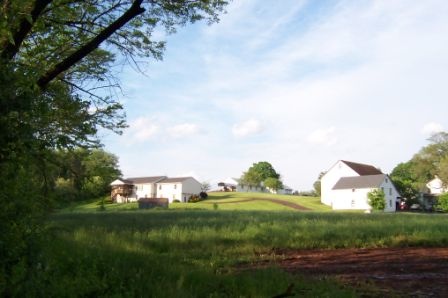
Living Hope Farm, near Harleysville, PA
by Heidi Martin, MCCN staff writer
During a time when unemployment is high and spending tight, the Franconia Mennonite Conference of Eastern Pennsylvania feels a call to begin a new ministry on a farm the conference owns near Harleysville, PA. The ministry, called Living Hope Farm (LHF), will begin as an organic market farm but the board has a vision that extends well beyond that.
“Everyone that I’ve talked to has a very positive sense that now is a good time for this,” says Greg Bowman, LHF board member and Mennonite Creation Care Council member. “There is a lot of enthusiasm and goodwill.”
The property was purchased by Franconia Mennonite Conference in the 1950’s for use as a rehab center for alcoholics. When that ministry ended, a new ministry began, caring for mentally disabled children. The Indian Creek Foundation group home is still active today.
The land was always special to Bowman who developed a horticultural therapy ministry as part of Indian Creek Foundation in the late 90’s. Spending time working in the various garden plots and traipsing the land left him mesmerized by the stream, wetlands, slopes and ridges. His vision for the property was extensive but, until recently, the ideas remained latent.
Since 1995, the conference discussed how best to use the property’s farmland, without satisfactory conclusions. A new energy among conference leaders and members sprang forth when the farm was in danger of being sold for development.
“We think there is something higher for this use of land [than development],” says Bowman. “We want to give other churches a sense of what’s possible in ministering to the community and in really witnessing. We want to help people rethink what it means to raise food, farm and manage livestock. We want to treat the land as special and sacred and to think of food as, not just calories, but a special gift.”
Bowman joined conference leaders in a two-step process of discernment. First, they assessed the vision and finances of the conference and created a five year vision and budget plan. Second, they analyzed their goals for three conference properties, the farm included. They decided to be intentional about using the farmland as a conference-wide ministry.
Not wanting to burden the conference, LHF is starting small. This past winter, the board hired Jill Landis to begin enriching the soil and improving the land. At the end of a two year period, board members hope the farm will be commercially viable and ready for healthy food production.
The farm will supply faith-based institutions, including retirement communities, schools and churches, with local food. Bowman believes this tends both physical and spiritual needs.
“The food will help to nourish folks who are in church-sponsored ministries which now can’t offer them opportunity to stay connected to the land,” says Bowman. “For me, producing high-quality food for known buyers who are part of a faith community is such a tangible way for discipleship to become exciting and visible and taste-able and touch-able.”
In the past, the push for profit and the increase in farming costs forced farmers to work the land in unsatisfactory ways and receive little benefit for their efficiency. With a new generation, a new interest in long-term sustainability is developing.
“It’s work that is exciting and is very much value-based,” says Bowman. “It has been really inspiring for me to see this generation come around.”
Bowman thinks the church is finally catching up to this agriculture interest. Perhaps churches are beginning to understand that, in the past, people have become isolated from the land and, therefore, isolated from creation. This disconnection is dangerous.
“Being disconnected, we risk not caring about the ones who steward the health of the soil, who rise in the dark and work in the cold to harvest our vegetables, who struggle against unjust structures to farm as well as they know they should, and who do not have the power to provide their families with food that nourishes them, delights them and honors sustaining stories,” says Bowman. “Being disconnected is to be unable to be truly grateful, truly mindful of God’s grace in promising seasons, rain in due time, enough seeds, and the sun to power the whole package.”
In recent times, the church is taking action to re-connect people and land. This is evident in the community gardens popping up on church property. Mennonite Weekly Review recently noted this development in an article called “Church Gardens a Growing Trend.” Also, Mennonite Creation Care Network shares many examples of community gardens on their website (climatejustice.mennoniteusa.org).
“Faith-directed sustainable agriculture and community gardens build connections, which flow from God and point to God and join us with God through one another in humble service to God’s earth,” says Bowman. “When we move from commodities to community, from fast food to real food, from mindless eating to respectful sharing of sacred food, we are doing transformative, counter-cultural, holy work.”
“A passionate, Christ-centered love for others that finds common work in creatively nurturing soil makes the story of God’s love of redemption, salvation and restoration so visible,” he adds. “It helps to explain those works which would otherwise be abstractions. When people see that in their own gardens and farms, there is a profound sense of wholeness.”
Bowman and the board believe that God will bring people who have energy and vision to the farm. He hopes for agro-ecology programs, vocational learning, youth camps and therapeutic horticulture programs that will enable LHF to live up to its new title and offer hope to other faith-based organizations, the surrounding community and the Mennonite church at large.
